Site editor:
Joaquim Cardoso MSc
The Health Transformation — journal & content platform
October 1, 2022
Kathleen M. Pike, PhD
September 30, 2022
Professor of Psychology and Director of the Global Mental Health WHO Collaborating Centre at Columbia University.
About a decade ago, a large multinational corporation invited me to speak to their employees around the world about mental health. The catch: I could not use the words “mental health” or “mental illness.”
At the time, these terms were too stigmatizing, too provocative, and too triggering in the world of work, so they asked me to talk about coping, resilience, and thriving instead.
Fast forward to last spring, when the same corporation invited me back for another workshop. As I entered the company executive’s office for a planning meeting, I was greeted with a poster on the door that read, “Feeling depressed or anxious? Want to talk? I am a mental health ambassador.”
My, how times have changed.
- 1.Mental health at work: By the numbers
- 2.Work, workplaces, and mental health.
- 3. WHO Guidelines: Who are they for and what are they intended to accomplish?
- 4. Key Messages & Recommendations.
- 5. Opportunities and Challenges.

1.Mental health at work: By the numbers.
Working adults spend more waking hours working than engaged in any other single activity.
An estimated 15% of working-age adults have a mental disorder at any point in time.
Data from 2019 estimate that 280 million people lived with depression and 301 million with anxiety, and 703,000 people died by suicide that year.
Pandemic, war, natural disasters, and socio-political events worldwide over the past few years have only added fuel to the fire, and workplaces are experiencing the effects firsthand.
WHO estimates that untreated depression and anxiety lead to approximately 12 billion working days lost annually, representing a cost to the global economy of approximately US $1 trillion each year, driven predominantly by lost productivity.
An estimated 15% of working-age adults have a mental disorder at any point in time. … around 280 million people live with depression, 301 million with anxiety, and 703,000 people died by suicide that year.
… untreated depression and anxiety lead …represents a cost to the global economy of approximately US $1 trillion

2. Work, workplaces, and mental health.
Sigmund Freud famously said, “Love and work… work and love, that’s all there is.”
As a cornerstone of our lives, work can be a protective factor for mental health or a detriment.
As a cornerstone of our lives, work can be a protective factor for mental health or a detriment.
Meaningful work is protective of mental health; it contributes to a person’s sense of accomplishment, confidence, and economic capacity and can contribute to recovery and inclusion for people with psychosocial disabilities.
Healthy work environments protect and promote workers’ mental health, and good mental health enables workers to contribute more productively and meaningfully at work.
Critical components of a healthy workplace include creating a physically and psychologically safe workplace, respect for diversity, equity, inclusion, and belonging, and worker engagement in strategy and decision-making throughout the organization.
Conversely, unhealthy work environments act as breeding grounds for factors like stress, inadequate employee support, limited work-life balance, excessive competitiveness, and a lack of transparency, marginalization, and disempowerment of employees.
Because we spend so much time where we work, workplaces can amplify wider societal issues that negatively affect mental health, including perpetuating stigma.
Critical components of a healthy workplace include creating a physically and psychologically safe workplace, respect for diversity, equity, inclusion, and belonging, and worker engagement in strategy and decision-making throughout the organization.

3. WHO Guidelines: Who are they for and what are they intended to accomplish?
In the past, mental health at work focused almost exclusively on addressing the mental health needs of individuals who were symptomatic and developing individual capacities to reduce stress and enhance coping and resilience.
While these are essential components of mental health at work, one of the major advances of the WHO Guidelines on Mental Health at Work is its focus across the continuum of mental health — from serious mental illness to psychological well-being and flourishing — and its focus on systems and structural aspects of work that impact workers’ mental health.
… WHO Guidelines on Mental Health at Work focus across the continuum of mental health — from serious mental illness to psychological well-being and flourishing — and its focus on systems and structural aspects of work that impact workers’ mental health.
The WHO Guidelines provide evidence-based recommendations for how organizations can protect and promote mental health, prevent mental health conditions, and enable people living with mental health conditions to participate and thrive at work.
The WHO Guidelines provide recommendations on how to address workplace conditions as well as interventions to enhance mental health at both organizational and individual levels, manager and worker training, and programmatic efforts focused on a return to work and gaining employment for individuals with mental health conditions.
The WHO Guidelines provide recommendations on how to address workplace conditions as well as interventions to enhance mental health at both organizational and individual levels, manager and worker training, and programmatic efforts focused on a return to work and gaining employment for individuals with mental health conditions.

4. Key Messages & Recommendations.
The WHO Guidelines offer recommendations for promoting and protecting workers’ mental health, including providing stress management, mental health literacy, and mental health awareness training.
These evidence-based strategies promote positive mental health, reduce emotional distress, and improve work effectiveness.
Mental health literacy and awareness training improves understanding of mental health and wellbeing at work, helps to reduce stigma, and encourages help-seeking behaviors.
The WHO Guidelines address the need for effective manager training related to mental health at work.
The guidelines also provide recommendations on expanding access to evidence-based psychological treatment for individuals with mental health conditions, committing to reasonable accommodations at work, and implementing return-to-work programs and supported employment initiatives that will enable more workers to engage in work successfully.
These evidence-based strategies promote positive mental health, reduce emotional distress, and improve work effectiveness.

5. Opportunities and Challenges.
The WHO engaged hundreds of colleagues from around the globe to contribute to the scientific review and synthesis of the extant data on workplace mental health.
The guidance is evidence-based and provides clear messaging regarding priorities and opportunities.
Translating global guidance into action for a given company presents opportunities and challenges.
Each organization will need to identify its own strengths, weaknesses, gaps, and priorities.
In addition, translating recommendations into practice requires tailoring efforts and interventions so that organizations can strategically invest resources that have real impact.
Our Mental Health + Work Design Lab is working with One Mind at Work and Ethisphere to develop an evidence-based and comprehensive approach to assessment and organizational development that enables organizations to measure their mental health services and capacity, improve their practices and programs, and innovate strategically so that they can do right by their workers and do well by their organizations.

Our team at Columbia University Mental Health + Work Design Lab had the privilege of contributing to the scientific research that informed the WHO Guidelines.
Contributions from around the globe make the WHO Guidelines a historic milestone along the journey of ensuring that work positively impacts mental health and vice versa.
Victor Hugo said, “there is nothing more powerful than an idea whose time has come.” Indeed, the time has come for mental health at work.
Victor Hugo said, “there is nothing more powerful than an idea whose time has come.” Indeed, the time has come for mental health at work.
About the author & affiliations
Kathleen M. Pike, PhD is Professor of Psychology and Director of the Global Mental Health WHO Collaborating Centre at Columbia University.
Originally published at https://kathypikephd.com on September 30, 2022.
Infographic
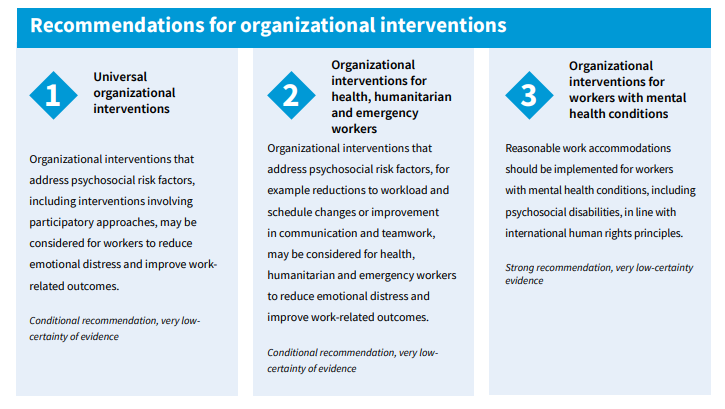
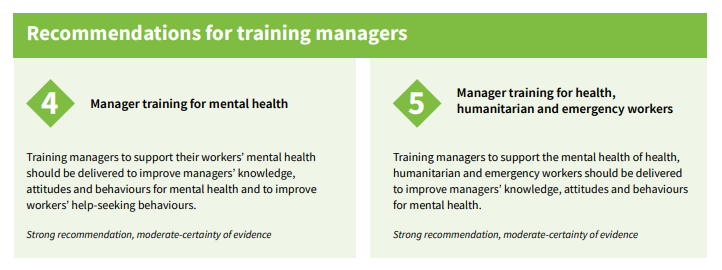
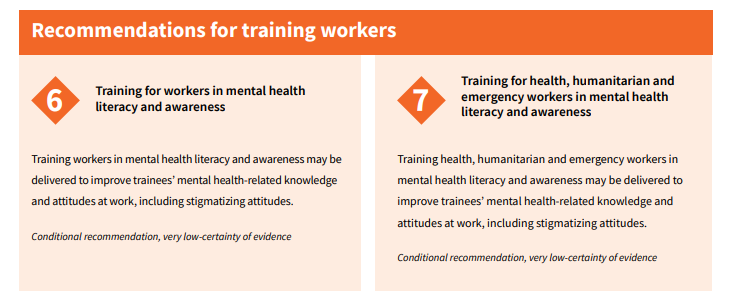
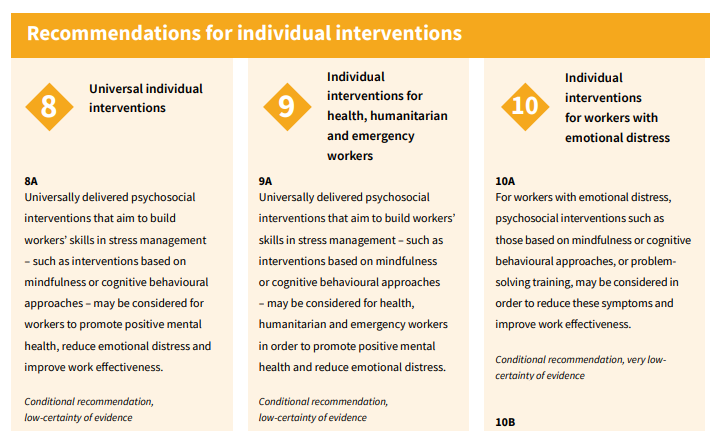
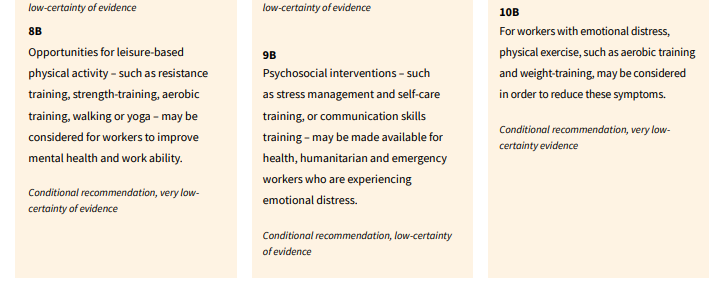
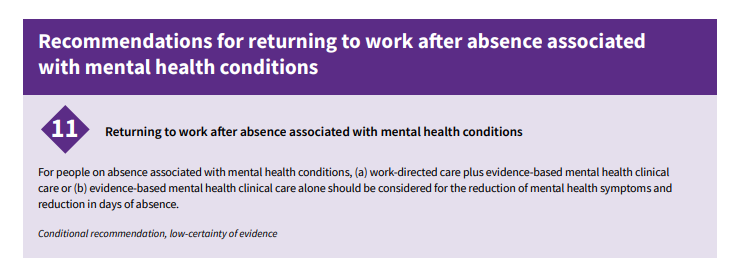
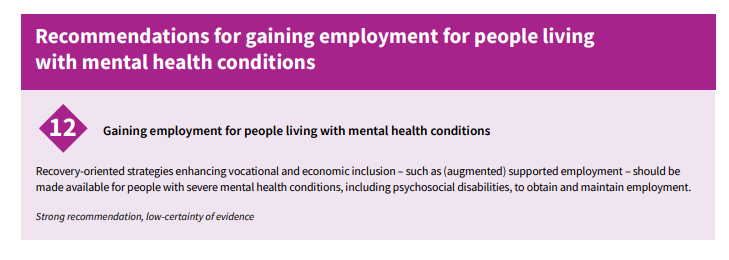

REFERENCE PUBLICATION
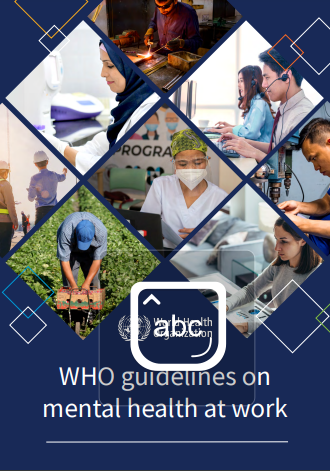
The WHO guidelines on mental health at work provide evidence-based recommendations to promote mental health, prevent mental health conditions, and enable people living with mental health conditions to participate and thrive in work.
The recommendations cover organizational interventions, manager training and worker training, individual interventions, return to work, and gaining employment.
The guidelines on mental health at work aim to improve the implementation of evidence-based interventions for mental health at work.












